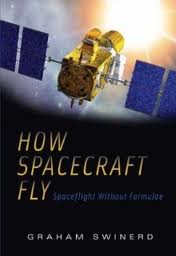 Subtitled “Spaceflight without Formulae”, How Spacecraft Fly does exactly what its title promises. Swinerd has worked in the space industry, and in academia, for almost thirty years, and has been extensively involved in providing training in spaceflight concepts to non-technical staff at ESA. This book comes in part from those training sessions. As a result, its audience is not intended to be have much scientific or technical knowledge – which does mean in some areas explanations are perhaps a little simplified. Nonetheless, How Spacecraft Fly covers all the relevant areas, and is useful for that respect.
Subtitled “Spaceflight without Formulae”, How Spacecraft Fly does exactly what its title promises. Swinerd has worked in the space industry, and in academia, for almost thirty years, and has been extensively involved in providing training in spaceflight concepts to non-technical staff at ESA. This book comes in part from those training sessions. As a result, its audience is not intended to be have much scientific or technical knowledge – which does mean in some areas explanations are perhaps a little simplified. Nonetheless, How Spacecraft Fly covers all the relevant areas, and is useful for that respect.
The book discusses orbits, both ideal and real, getting into orbit, the environment of space, and the various subsystems involved in spacecraft design. For “spacecraft”, Swinerd writes almost exclusively about uncrewed spacecraft – probes and satellites. The final two chapters, ‘Space in the 21st Century’ and ‘Space: The Final Frontier?’, cover future crewed space missions, but only in overview.
The lack of formulae, as promised in the subtitle, does make the book an easy read, but makes it of less use to those with a deep interest in the subject. Swinerd’s example figures must be taken at face value, and there’s no opportunity to plug in figures and so determine results for alternative cases. For the sections on spacecraft design, this is less of an issue, but the orbital mechanics chapters would probably have benefitted with demonstrating the use of some formulae. Having said that, there are plenty of more advanced books on the subject available, on to which an interested reader can move. How Spacecraft Fly makes plain it intends to be an introductory text and no more.
Swinerd’s style is very readable, and he gets across information in an easily understandable manner. If his training sessions were anything like How Spacecraft Fly, I can believe his boast that they proved very popular among ESA staff. The diagrams throughout the book are clear and well laid-out, although many do look a bit too much like free clip-art.
As someone who is interested primarily in the engineering and hardware of crewed space exploration, my knowledge of the actual physics involved in sending astronauts to the Moon, or throwing them up into LEO, is no doubt somewhat deficient. I bought How Spacecraft Fly with an eye to remedying that lack. The chapters on orbital mechanics were of more use than those of satellite design, though I found the latter more interesting as the subject was newer to me. The former was perhaps pitched a little too low – I may not be an amateur astrophysicist, but I’ve read enough books on spaceflight to pick up some of the physics involved. But, as promised, How Spacecraft Fly does very well as an introduction to the topic, and those interested in it could do much worse.
For those interested in learning more, there is a website here associated with the book.
How Spacecraft Fly, Graham Swinerd (2008, Praxis Publishing Ltd, ISBN 978-0-387-76571-6, 261pp + index and 4 colour-plates)